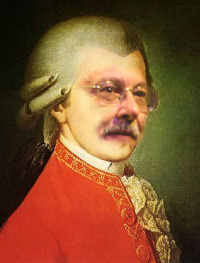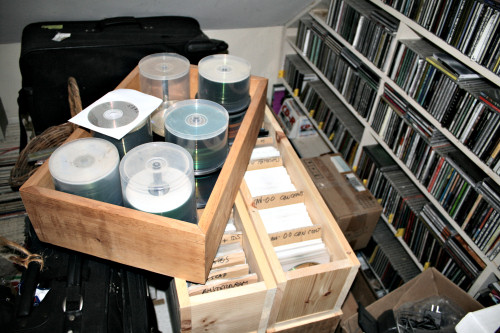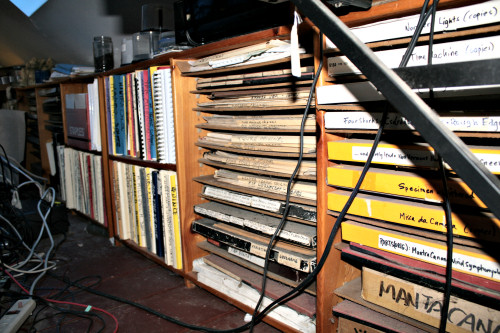A 365-Day Project
"We Are All Mozart"
A project to create
new works and change
the perception of the
music of our time.


 January 24, 2008
January 24, 2008 
Yesterday was janitorial day, with file cleanup. How, my wife Stevie wonders, could I collect so much digital junk? And why keep it? The latter answer is easy: I'm an archiving packrat. Artists seem to be divided on this behavior -- some keep nothing, their spaces pure, their lives portable. Others keep every scrap of their artistic lives because those scraps have meaning and form a living organism of time and object. It's the manifest burden of the mind. And odd that archiving began two days ago, as yesterday's Colin Holter topic on NewMusicBox considered what it means to come across forgotten pieces of one's artistic past.
Early in my musical life -- with music starting late, that meant ten years into that life at age twenty-seven -- it became clear that all my sketches and quite a few early compositions had become a burden. With titles like A Life Fulfilled and Fanfare & Pyrotechnics and Desire: An Operatic Vision, there was little chance of these having a rich and rewarding existence, much less deserving one. I plucked the forty worst to die and left about one hundred to live another day. On May 23, 1976, these forty compositions were driven to the second Delaware Valley Festival of the Avant-Garde in Trenton, New Jersey, and burned, one by one ... but not before offering the gathered public the opportunity to purchase each one to save it from the fire. No one asked. All the scores and tapes burned.
And even while cleansing the spirit of the past, that Detonacy did leave a hole in the living organism of time and object. Friend and fellow composer John Levin lost his home to a fire a few years ago, as did composer John McGuire and his wife singer Beth Griffith. I can't imagine. There was a throbbing ache as I heard their stories. So although I'm anxious to strip away the abundance of stuff, the art -- mine and others' that are here in this home -- matters. There are costumes from a chamber opera that will likely never be done again, and a dozen hand-built instruments, posters and graphics, drawings and paintings and sculptures (a few of mine but mostly others'), pencil and inked manuscripts and copies from the very first ones surviving Detonacy 1976, photographs and negatives since my childhood, audiotapes back to my first concerts in the late Nineteen Sixties and later videotapes along with every form of equipment to play them, bags of cables and boxes of peripherals, crates of articles and every letter sent or received that hasn't been lost or forgotten somewhere, and even a rented storage space with the entire contents of my electronics shop that once occupied a room at Morel Electronics in Barre, Vermont, the shop where I built equipment for soundscapes and installations and performances. All the books save college texts sit in the house's library and on walls of shelves in the other rooms, as do two thousand LPs and as many CDs and even 78s, tapes of interviews and commentaries dating back forty years, concert tickets and programs, tools of every configuration including a book press, a dozen computers (but only those with a once and future use as part of an artistic endeavor), beautiful glasses and wooden boxes and postage stamps (these last three being the few things I actually collect for pleasure, along with a massive train set that I've slowly cobbled together but will likely never be set up and instead be given to the grandchildren), and even phone messages from Stevie and a plastic bag with my hippie ponytail. What would you make of what I don't keep? Financial records, receipts, clothes, extra equipment, cars, and that electronic shop once it's sorted and put on eBay. That's not much, but then I don't buy much that I don't need as part of an artistic life. One year in the mid-Nineteen Seventies my only footwear was a pair of corduroy slippers that I wore everywhere, including to work. I've owned only five vehicles since I started driving in 1964: a Plymouth Valiant, a Plymouth Horizon, a Dodge Omni, a Dodge Neon, and a Ford Ranger.
Back on track. Having closets and shelves full of mass makes some sense, but to answer Stevie's first question, how could I collect so much digital junk?
Sketching scores is not part of my work now, except as a reminder, a kind of neume. But digital formats are risky. A few bits out of place and the work is destroyed. So at each pause in the compositional thought process, I almost unconsciously type ALT-F-A, bringing up a "Save As..." dialog, where I enter an incremental filename. What begins as a "vexation-001.mus" Finale file grows through "vexation-077.mus" and ends at the final draft of "vexation-123.mus". There are so many drafts in so many formats (PostScript and PDF and audio) that disks begin to fill. So when I completed archiving the "We Are All Mozart" project last last night, there were nineteen DVDs of material, some sixty gigabytes worth. Will anyone care about it? Probably not. Not even me, most of it. But I flush and forget once I've created a piece, so should I need to satisfy curiosity in wondering how a phrase came about, or should I want to steal from myself, the sources are there. I can reach back to learn that a piece began with scanning a photograph, or grew from a fractal formula, or had six false starts. It will all end up in the dump, but for now it's part of that time and object webwork.
And so I can dip back to write about these WAAM pieces by reminding myself what I did to compose them. On the cold morning of December 8, for example, my flashcard recorder and binaural microphone were turned on and carried from the studio down the steps, out the door, toward the barn, around the grounds to the dam, by the river, through the bridge, and back. The snow crunched, the stairs clunked, and the pause to feed the cats and fill the woodstove was recorded. It ran the entire early morning and collected hundreds of unique footfalls until it was time to settle in for a day of composition -- for which these recordings would be the raw materials. A clip here and a sound there were collected in temporal order, overlain with parallel sound streams, with added compositions from the WAAM project itself, and compressed into a full morning in thirty-eight seconds -- the length requested by Rob Voisey for his commission. In a tip of the verbal hat to the work of Johann Fux, I called this 'day getting ready to compose this piece' recursive piece Morning Steps (to Parnassus). There is this official version and this remix for my own interest.
Dante Oei commissioned the piano piece composed on December 9. Writing for brilliant Dutch performers is tough because they are not always comfortable with American musical sensibilities. A strong theoretical underpinning is expected, often along with a confrontation of the extant, and the stream-of-consciousness or gut-level modes of composition don't make an easy fit. Still, as time has passed, the integral gut-level composition has become increasingly important to me. Perhaps it's because my skills and talents are in synchronicity and whatever theoretical underpinnings exist are deeply intuitive. I don't know. But the discipline of choosing a method of spinning out a composition is still compelling, and I was glad to dig into his commission. For Dante there would be several layers: a fractally-generated upper line using modal patterns; a stride bass that was deconstructed before being reconstructed step-by-step in two distinct Nyquist-like 'waves'; and a central rhythmic exchange between points which would otherwise be rests. Without the upper fractal or stride patterns being shifted at all, the piece gains a bluesy congruence from its structure -- a plain old twelve-bar blues. Because the upper part is so strenuous, the piece is called Vexation Blues; the score is here and a demo is here.
On December 10, a piece due earlier was finally completed, and it was a tough one. The term "art song" gets a strongly curled lip on this face. I was a music student at Rutgers University at the height of the stuffed-shirt performances of Schubert Lieder by Dietrich Fischer-Dieskau, beloved by many and loathed by me. Here, watch this 1959 performance. So when asked to write an art song, I am simultaneously terrified and discouraged. In this case, it got worse. It was commissioned by David Bremner for his wife, well-known soprano Elizabeth Hilliard, as a Christmas present. And it was Catullus, a favorite poem of theirs, in Latin.
Okay, I did study Latin. Three years of it, and I can still "hic haec hoc" in under ten seconds. But real Latin, text that meant more than breast-beating "alea iacta est" from the far side of the Rubicon, that was tough. Here is the forty-second poem of Catullus:
|
Adeste, hendecasyllabi, quot estis |
There were translations online, either creaky and bowdlerized or modern and not-quite-right. So I contacted my old friend, composer and classics professor emeritus from Middlebury College, William Harris. What did it mean? How could it be worked with? Bill wrote, in part:
|
I was just thinking of the hendecasyllabic line, and if it connects with your music schema. Here is a rough outline: First foot can be __ or _u of even u-. Then generally a dactyl -uu, and continue with trochees to the end. There are lots of substitutions and rearrangements but the line is tight, fast moving, and for Romans hard to do. It is trochaic metre (troxos = running) and natural for Greek but hard to do in Latin, hence gets attention. It is a jerky, fast-moving poetic line which fits the dancy tone of the poem, and matches the meaning nicely. That 11-syllable line is most peculiar, part of a glyconing and something added on to make a decent length. X means long/short: xx/ - uu/ -u / -u/ - X. So the first two beats are a sort of lead-in, can be absolutely anything from - - to uu or . . . A sly beginning which is low key and indecisive, then that dactyl familiar from epic poetry and Homer, then the running trochees to the end with a ? at the last syllable. da da DA du du DA du Da DU DA ? pause. For a language familiar with the iambic "da DA" like "To be or not to be", this DA da is sort of mean and sarcastic, like screw you, fuck off. Which is why Catullus likes it so well and uses it so much. Also: hendekasyllabi is a most curious foreign and academic word, must have caught the laughing eye of the poet and suddenly he realizes the word has a poetic meter: HEN de ka / SYLL a / BI, so writes it into the poem and lets it dance for a while in the street asking for the Notebooks back in which the HEN de ka / SYLL a / BI are incorporated. Problems with words: pugillaria are little hand-size notebooks like what reporters use, actually wood to be waxed for writing. But for the hand, cf. pugna = fight (hand) and pux "a blow with the hand". Rare word. Codex (later the block form of a parchment book) is originally a block or plank of wood. Codicilli are tablets waxed for draft writing, larger than the small ones. Really notebooks of verse, but too long so, books. Could say booklets but sounds bad. Moecha = adulteress, but not technically so a slut. Scum is right for lutum which is mud-dirt. Scumbag used for any bad sex word, but should be for a male (scum in a condom originally) but probably okay here, carries the point with a surprise word. Gallican dog I think is a hunting dog, hence drool not like a lady's poodle. Trolls, maybe consider it here. There are real language and cultural connections between the Latin and Celtic languages, so not philologically baseless. But it needs a visual bit to go with the grammatical number elevens. |
And so Bill not only helped, but he also threw an enormous additional ambiguous load onto the thought-heap -- and he made this art song prospect exciting. I dragged myself through the words, through the approach, churning through my personal mud. Art song, art song, art song, art song, art song, art song, bleagh! It had to have guts, have something that Diamanda Galas might approach. I took Bill's eleven syllables and made a chant, that diving into a harshly rhythmic accusation, and the whole piece proceeding as an increasingly agitated confrontation, ending with flattery and a plea formed like the opening chant. Here are the words as Bill re-translated them (and you can read his further analysis on his humanities website).
|
Attention, all you little polysyllabic Elevens, |
I decided to take this as an autobiographical text between the narrator (with several personae) and the muse.
The opening is the conspiratorial call, chantlike, to the 'eleven' -- and also, as Bill suggests, the 'elves' of the narrator's person. The use of a chant-like opening in classical Latin is deliberately conflicted, because it isn't Vulgate and it isn't modal. Once the conspirators have been brought together, the frustration begins. The eleven-syllable poem has been set in its poetic meter LL LSS LS LS LS, resolving to 2/4+(1/4+2/8)+3/8+3/8+3/8, simplified to 2/4+4/8+9/8, but feeling out at 81/2/4. Catullus becomes Fellini.
The melody mixes modal, eastern, whole-tone and tonal sections in essentially four figures, including the 'iocum' drop/echo, the descending scales, and the repeated pitch. Each of these attaches itself to the text. The outlier is the mocking of the muse (by the narrator and probably the internal elves, the personality's children) done by the fourth figure, a distorted version of ring-o'-roses. I particularly like this because not only does it imply multiple voices but also it calls back to the plague. Throughout the frustration secton, the accompaniment echoes and pre-echoes the material, and the bass repeats in both exact and broken loops. "Give me! Give me!"
The only way to talk to the muse ends up being in the same tones (and same melody) as used for the elves -- the muse brought into the conspiracy, creating a twelfth conspirator. Take what you will from that eleven-become-twelve, including the overwhelming of the Catullus world by the Christian one. I liked the disturbing suggestion of a Last Supper ending.
The song is to be sung in classical Latin rather than Vulgate, and to emphasizes that, there are syllables with separated consonants. These are sounded 'hard', as separate sounds rather than propelling a vowel: "circum-" as k'eer k'oom; the separated p in "p'ugillaria"; and a long rolled r in "ridentem." The slides are not classical portamenti or glissandi, but the slides of blues or cabaret, starting or ending at some undefined point in the vocal range. There are places somewhat akin to harmonic singing. A 'rough throated' section isn't hooty Sprechstimme, but the near-pitched spoken sound of, again, blues or cabaret. A vocal 'creak' is a particular Generation X speaking sound where the vowel isn't purely expressed, but arises from a throat rattle, as in the voice of Chan Marshall.
There's the score to XLII: Adeste Hendecasyllabi, but the demo is poor -- the voice is represented by strings, none of the important vocal effects are there, and the rhythms are entirely mechanical. I really hope that Elizabeth gives a killer performance so you can really hear what it sounds like. Anyway, here's that demo for now, and if you hear a real voice, you know it's been replaced by an actual performance since I wrote this sentence.
Twenty days were left in December and thirteen pieces waiting to be composed. Hoo-hah! More next time.
* * *

Fragmentary part of the digital archive. The wooden boxes go down four levels and another four are being built. The CD shelves go up to the ceiling on both sides.

Row of scores from the paper music days. Most of the music has been digitized, so these are the pencil manuscripts, inked versions, and parts, as well as fair copies of the digital versions.